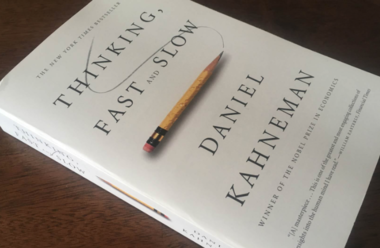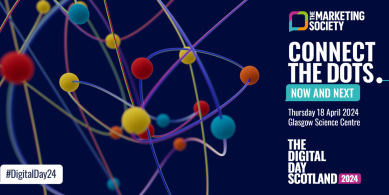Marketing can be fast paced and seemingly subject to change all the time. We can, occasionally, be guilty of not taking enough time to stop and think. Equally, there is an intellectual requirement to our profession that can, at times, create a “paralysis by analysis.”
I know that throughout my career I can reference a few examples that reflect both of these scenarios. So while it may be odd to select a book that invites the reader to think about thinking, it’s against this premise that I have chosen Nobel Prize winner, Daniel Kahneman’s Thinking, Fast and Slow.
The topics addressed in this unsurprisingly thoughtful book are both complex and integral to the human mind: Kahneman asks us to consider how our mind habitually contradicts itself, distorts data and misleads us.
With much being made in recent years about behavioural economics and the extent of the influence our profession has on people, the ability to understand how we think is a useful tool in any marketers armoury.
“Two Systems”
In order to really understand our thought processes we subconsciously apply two cognitive systems.
System One is the mental process that reads emotions and handles our automatic skills, such as driving. System One is based on instinct and habit, including biases. It’s fast.
By contrast, System Two occurs when we’re focusing on specific details and applying effort consciously, such as filing our tax return, trying a new sport such as golf or searching for a friend in a crowded pub. For methodical thinking processes such as formal logic, you need System Two thinking and you guessed it, it’s slower…!
Generally speaking, we tend to value the measured System Two while dismissing the mechanical System One, but the reality is much more complicated. These mental processes engage in a division of labour when it comes to thinking, and they constantly interact. We usually live in System One’s world, where it’s fast processing is extremely efficient. In fact, we can be reasoning about a task in System Two, get tired or distracted, and find that we’ve shifted over to System One without even realising it.
The system that we use and how we think depends a lot on the effort we are expending. If we are doing something easy, like walking along a known path, we’re using System One and so we have a lot of cognitive capacity left for thinking. However, if we push the pace to a speed walk, System Two switches on to maintain our efforts. Now if we try to solve an arithmetical problem, then we’re likely to stop walking altogether because our brain can’t handle the additional burden.
If our System Two is busy, we’re more likely to stereotype, give in to temptation or consider issues only superficially. System One likes to jump on the straightforward answer, so if a seemingly correct solution quickly appears when we face a challenge, System One will default to that answer and cling to it, even if later information proves it wrong.
Pairing
Having grasped that background context, of even greater interest for marketers, is something that System One performs called “rapid associative activation.” If two words are paired (or a word and an image) then our minds will link them, weaving a story from those scraps of information. Let’s think about this in the context of Coke’s seminal Open Happiness campaign. And then again, with the phenomenon of “priming,” when paired words can create instantaneous connections that lead to physical reactions; for example, when exposed to the word “drink,” we will more likely complete the sequence C-O-_-E as Coke rather than cone.
For marketers looking to create effective activations, we must appeal to the System One preference for simple, memorable information. This is why bold fonts, rhyming slogans and easy-to-say brand names have proven successful. These tendencies are markers of System One’s larger function, which is to assemble and maintain our view of the world. System One likes consistency. For example, seeing a car in flames stands out in our minds but if we were to see a second car on fire at roughly the same spot later on, System One will label it “the place where cars catch fire.” This is why consistency around a brand’s visual assets is so important.
Anchoring
System One is also responsible for the principle of “anchoring.” This occurs subconsciously when thinking on a topic is tied to information that has been recently encountered, even if the two have nothing to do with one another. Anchoring can also be an effective approach to achieving a price premium. Value is subjective and we are only capable of assessing value through contrast and comparison. So if we were to compare a product priced at £10 to one at £50, the product priced at £50 feels expensive. But if that same product is compared to one that is priced at £150 then it comparatively feels better value, especially when contrasted against the £10 product, which now feels cheap.
Risk
Habitual contradiction and distortion are recurring themes and this is especially evident when we come to assess risk. Loss aversion is a well-known feature of the human psyche for example, we’d hate to lose £100 more than we would like to win £150. In the financial world, market traders buck the trend by not conforming to System One’s emotional reactions to losses. This in-built pessimism aligned to heavy regulation illustrates why it can be particularly challenging to market certain financial services.
That said the endowment effect (when we own something, we tend to overestimate its value relative to the value of things we don’t own) has done much for the insurance industry. Especially when combined with the fact that we regularly misjudge the frequency and likelihood of rare events.
And finally, how we frame risk shapes our evaluation of it. When we hear a life-saving vaccine has a 0.001% risk of permanent disability, our reaction is disproportionate to our reaction when the same statistic is presented in a format that states the treatment leaves one in 100,000 individuals forever incapacitated.
This rigorous and refreshingly honest book exposes the fallibility in our minds. It supports the view that the key to making good decisions depends on paying attention to where information comes from, understanding how it is framed, assessing our own confidence in it and gauging the validity of data sources.
Of greatest significance however, is that because a company can operate with more methodical rationality than the separate individuals within it who find it difficult to catch glitches originating in our own System One thinking, Kahneman reminds us of our responsibility as marketers to not deliberately exploit human weakness for commercial gain.
Newsletter
Enjoy this? Get more.
Our monthly newsletter, The Edit, curates the very best of our latest content including articles, podcasts, video.
Become a member
Not a member yet?
Now it's time for you and your team to get involved. Get access to world-class events, exclusive publications, professional development, partner discounts and the chance to grow your network.




